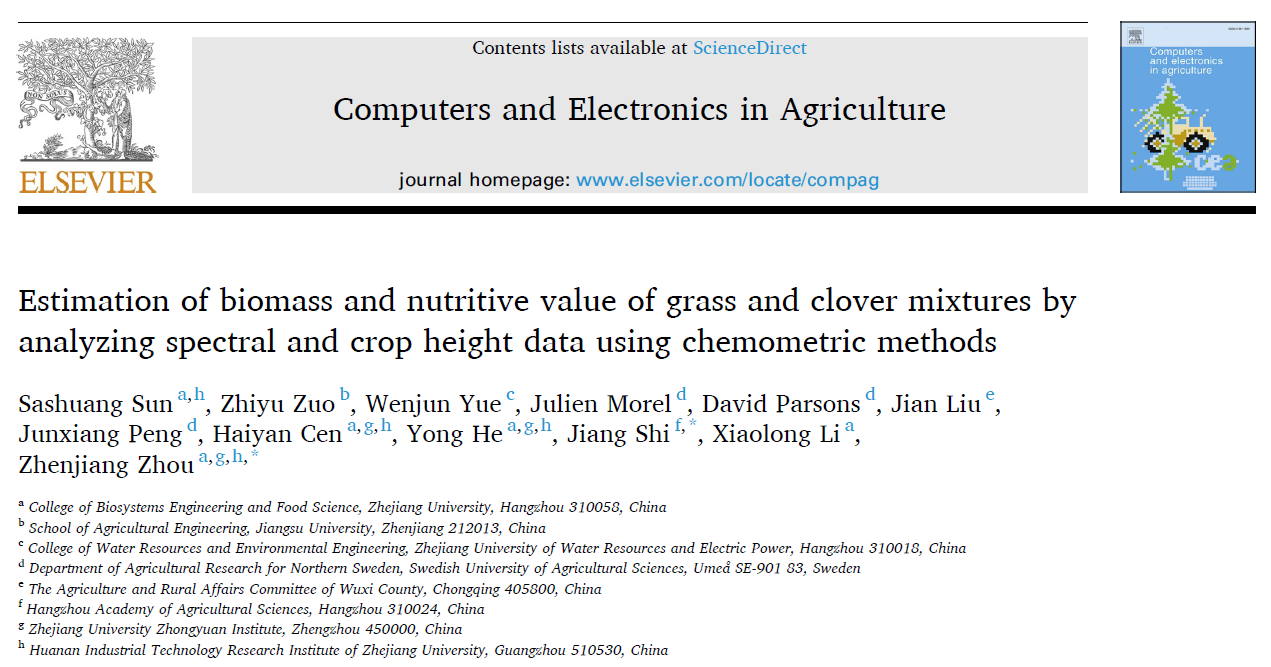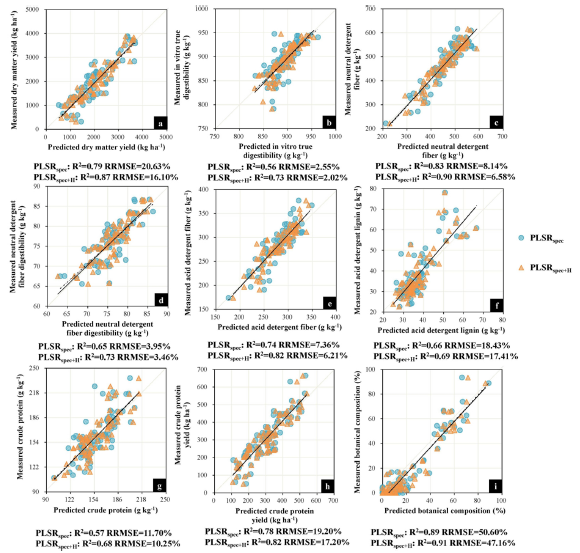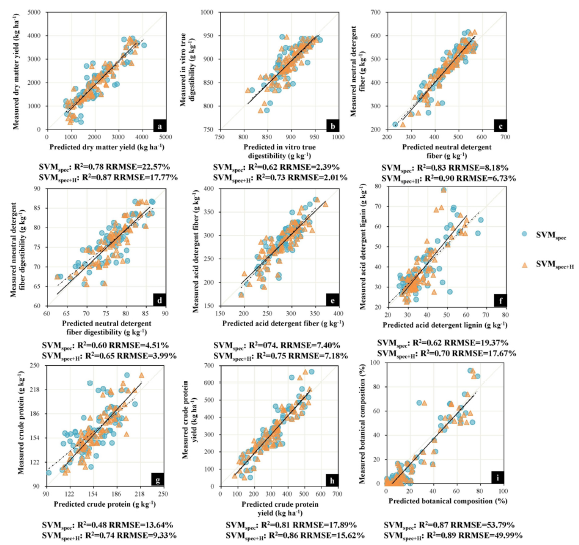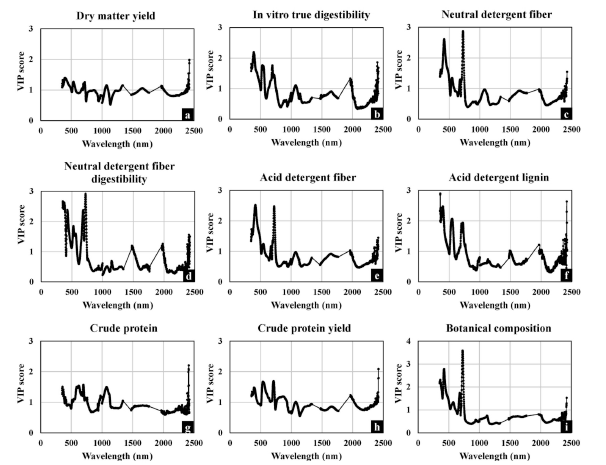Estimation of biomass and nutritive value of grass and clover mixtures by analyzing spectral and crop height data using chemometric methods

Accurate estimation of forage characteristics is needed to guide decision making on fertilization and harvesting schedules for farmers. It is a common practice to estimate forage nutritive value by laboratory analysis, which limits in-field decision making. Field spectroscopy offers a nondestructive approach to obtain crop biochemical information by measuring and analyzing canopy spectral reflectance (CSR). Crop height is an important agronomic parameter that is closely associated with forage quality. The combined use of canopy spectral reflectance and crop height can improve the estimation of fiber and protein content in heterogeneous pastures when compared to spectral information alone. The combination of spectral sensor and crop height data could be a promising tool to assess forage yield and quality in the field.
Based on this, in this article, a group of scientists carried out field experiments to obtain biomass and nutritive value and canopy spectral reflectance (CSR) of grass and clover mixtures with a spectroradiometer (ASD FieldSpec® 4 Standard-Res, Inc., USA) during 2018 and 2019 at Röbäcksdalen (63°48′ N, 20°14′ E), Northern Sweden to estimate forage yield and quality parameters by fusing CSR data and crop height information using PLSR and SVM.
[Results]
Results showed that both PLSR and SVM could reasonably estimate forage yield and quality variables, although performances of PLSR were more stable in terms of R2 and relative root mean square error (RRMSE) for both calibration and validation. Prediction performances of models using only full spectra data (PLSRspec) and models also using crop height information (PLSRspec+H) as model inputs were compared in this study. PLSRspec+H presented higher R2 and lower RRMSE than PLSRspec models (e.g. R2 improved from 0.83 to 0.90 for NDF and from 0.56 to 0.73 for IVTD, and RRMSE decreased from 8.14% to 6.58% for NDF and from 2.55% to 2.02% for IVTD). In addition, PLSR that used sensitive wavelengths and crop height (PLSRwave+H) as model inputs also had good performance, although slightly worse than PLSRspec+H.

Validation of partial least squares regression using full spectra (PLSRspec) or full spectra plus height variables (PLSRspec+H) for estimating (a) dry matter yield, (b) in vitro true digestibility, (c) neutral detergent fiber, (d) neutral detergent fiber digestibility, (e) acid detergent fiber, (f) acid detergent lignin, (g) crude protein, (h) crude protein yield, and (i) botanical composition. Black solid and dashed lines signify the linear regression fitting lines of PLSRspec+H and PLSRspec, respectively.

Validation of support vector machine using full spectra (SVMspec) or full spectra plus height variables (SVMspec+H) for estimating (a) dry matter yield, (b) in vitro true digestibility, (c) neutral detergent fiber, (d) neutral detergent fiber digestibility, (e) acid detergent fiber, (f) acid detergent lignin, (g) crude protein, (h) crude protein yield, and (i) botanical composition. Black solid and dashed lines signify the linear regression fitting lines of SVMspec+H and SVMspec, respectively.

Scores of variable importance in projection (VIP) of spectral variables for (a) dry matter yield, (b) in vitro true digestibility, (c) neutral detergent fiber, (d) neutral detergent fiber digestibility, (e) acid detergent fiber, (f) acid detergent lignin, (g) crude protein, (h) crude protein yield, and (i) botanical composition using partial least squares regression models with the inputs of full spectra and crop height variables (PLSRspec+H).
[Conclusions]
This study demonstrated the feasibility of combining canopy spectra with auxiliary growth parameters (i.e. crop height) to estimate forage biomass and nutritive value using PLSR and SVM. In terms of R2 and RRMSE, SVM performed satisfactorily, especially for estimating NDF and CPY, although overfitting was evident in the estimation of some variables such as IVTD and ADL. Overall, PLSR showed stable prediction results between the calibration and validation sets. In addition, the performance of PLSRspec+H models using two types of explanatory variables (i.e. full spectra and plant height) were superior to the PLSRspec models using only full spectra. PLSRwave+H had great potential to simplify estimation models by using fewer explanatory variables. The proposed method in this study showed reasonable accuracy for predicting DMY, IVTD, NDF, NDFD, ADF, ADL, CP, CPY, and BC variables. The results constitute a promising method for practical applications. It is reasonable to assume that the proposed methods could provide a reliable tool for producers and managers to assess the performance of grasslands and make timely fertilizer and harvesting decisions.
 Estimation of biomass and nutritive value of grass and clover mixtures
Estimation of biomass and nutritive value of grass and clover mixtures